Twin benefits of mangrove plantation in Sundarbans: building resilience to climate change and supporting rural livelihood
A joint effort by rural women in the Sundarbans and a non-profit is helping restore mangrove cover. The initiative is expected to reduce the impact of cyclones while it is also an income source to the women who are both planting and guarding the mangrove saplings.

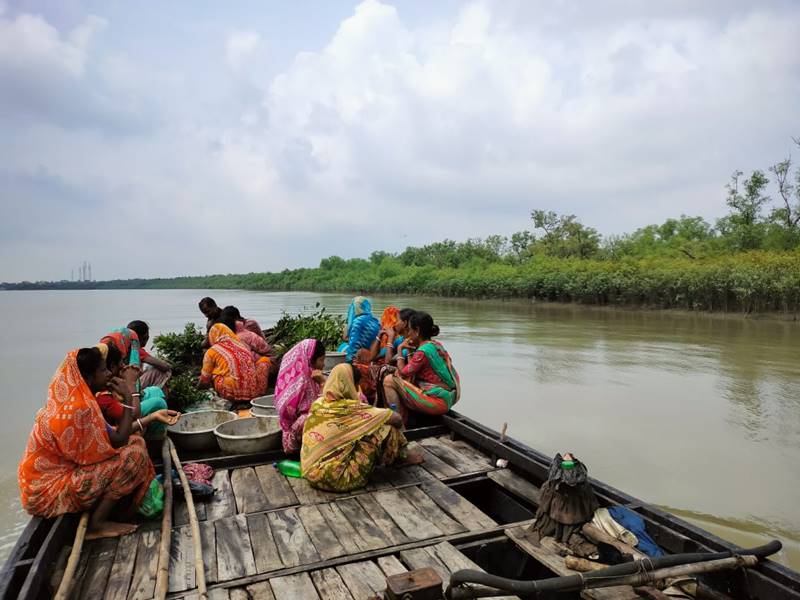
A unique initiative led by a group of rural women in the Sundarbans is trying to create ‘green barriers’ along the coast. All photos: SEEDS India
It’s been over a year but the residents of Gopal Nagar gram panchayat in the Sundarbans are yet to get over the frightful and ferocious Amphan cyclone that hit them last May during the COVID19 lockdown as it tore through their village uprooting coconut trees and inundating their farmlands and freshwater ponds with sea water.
“We lost joumeen (land), jaijaat (property), pukur (pond), graha (house), dhan (crop) in the cyclone,” 35-year-old Rintu Das, who lost her goats, cows, and kachha house in the Cyclone Amphan, told Gaon Connection. “Saline water entered our fields and ponds. It damaged our soil and killed our fishes. Now everywhere there is salinity. Amra ki korbo? (What will we do?)” asked an exasperated Das in her local language Bengali.
The villagers in Sundarbans delta of West Bengal are no strangers to cyclones. But in a warming world and the changing climate, as tropical cyclones get more intense and their frequency increases too, inhabitants of the delta islands are finding it hard to sustain their lives and livelihoods. As the sea level rises, several of these islands are slowly sinking.
Also Read: Power supply restored, but Cyclone Amphan has wiped off all livelihoods in the Sundarbans
A unique initiative led by a group of rural women in the Sundarbans and supported by a non-profit is trying to create ‘green barriers’ along the coast in order to build resilience to face extreme weather events and natural disasters such as cyclones.
Over 16 women associated with Banashree Mangrove Suraksha Committee in Gopal Nagar gram panchayat of South 24 Parganas district are working with Sustainable Environment and Ecological Development Society (SEEDS) India, a non-profit building the resilience of people exposed to disasters, to plant and guard thousands of mangroves in their Gopal Nagar village.

As part of the joint initiative, over 6,500 mangroves, including indigenous species such as timber, are being planted in five-acre (two hectares) land along the bank of the local Gobadhia river, a tributary of Hooghly. The project was kicked off recently on August 15 on Independence Day when over 3,000 mangrove saplings were planted by the village women on a single day, who are now also guarding them daily.
Thus, apart from responding to the climate change induced threats, such as sea level rise and salinity ingress, the mangrove plantation is providing livelihood opportunities to the rural women, who have signed a contract with SEEDS India and are being paid to nurture and guard the mangroves.
The Sundarbans delta
Over the past three decades, the ecologically fragile Sundarbans region in India and Bangladesh has lost 24.55 per cent of mangroves (136.77 square km) due to erosion. Most of the erosion is permanent.
It is vital to understand the importance of mangroves at a time when frequency and intensity of extreme weather events such as cyclones are predicted to increase in the future. Mangroves are a group of plants that can survive in salty soil and tides. They act as an effective barrier against disasters such as cyclones by protecting the earthen banks as well as reducing the damage.

A 2005 study published in the Journal Science indicates that a density of 30 mangrove trees per 100 square metre can reduce the flow of a tsunami wave up to 90 per cent.
Also Read: Cyclone Amphan’s anniversary of despair
“Land mass in West Bengal is very shallow. Because of high surface temperature, the intensity of cyclones and high tides has gone up. Mangroves break the speed of waves during a cyclone. They are line of defense,” Sanjay Vashisht, Director, Climate Action Network South Asia (CANSA), told Gaon Connection. CANSA is a coalition of more than 300 civil societies organisations working in eight South Asian countries to promote action to address impacts of climate change.
“Mangrove is also a hotspot of biodiversity and plays an important role in building resilience for communities that live in the coastal areas. Fisheries is one of the livelihood options for communities in Sundarbans. The mangroves provide habitat for fishes,” Vashisht added.
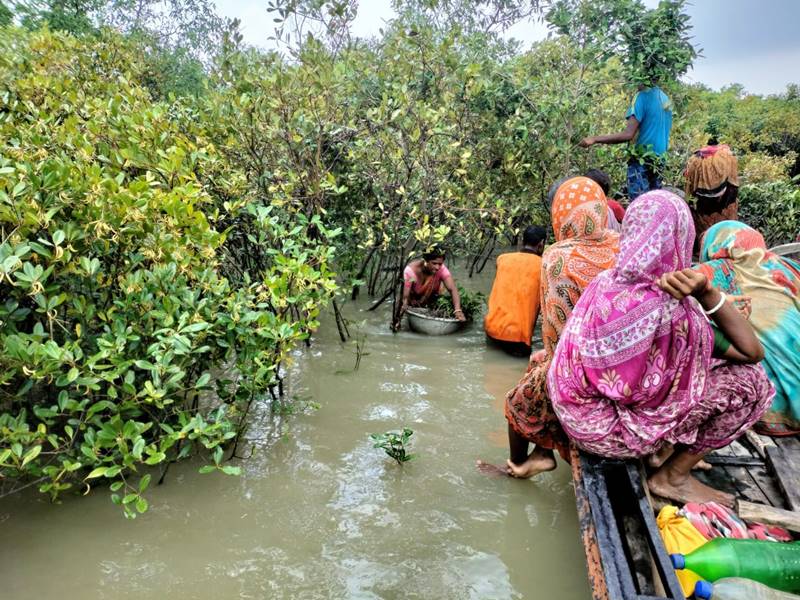
Mangroves to rescue
Gopal Nagar gram panchayat in South 24 Parganas district is considered one of the vulnerable villages in the Sundarbans. The village has faced several cyclones including Cyclone Yaas (2021), Cyclone Amphan (2020), and Cyclone Aila (2009).
Local people have time and again lost their livelihood, livestock, mud houses. A survey by SEEDS India showed that about 300 settlements in this village were destroyed by Amphan that left a trail of destruction and devastation in the state last year.
Also Read: COVID19 and Cyclone Amphan batter Hobjapara’s ‘migrant’ families
By planting mangroves, the villagers hope to create a natural barrier to protect them from the impacts of cyclones.
“As part of the mangrove plantation in our village, we first went to the forest early in the morning by boat to collect the saplings from the mangrove forest. Next day [August 15], some saplings were planted by the forest officials and then we women took over. We dug small pits and planted all the saplings till evening,” Rintu Das, a member of the self help group, told Gaon Connection.
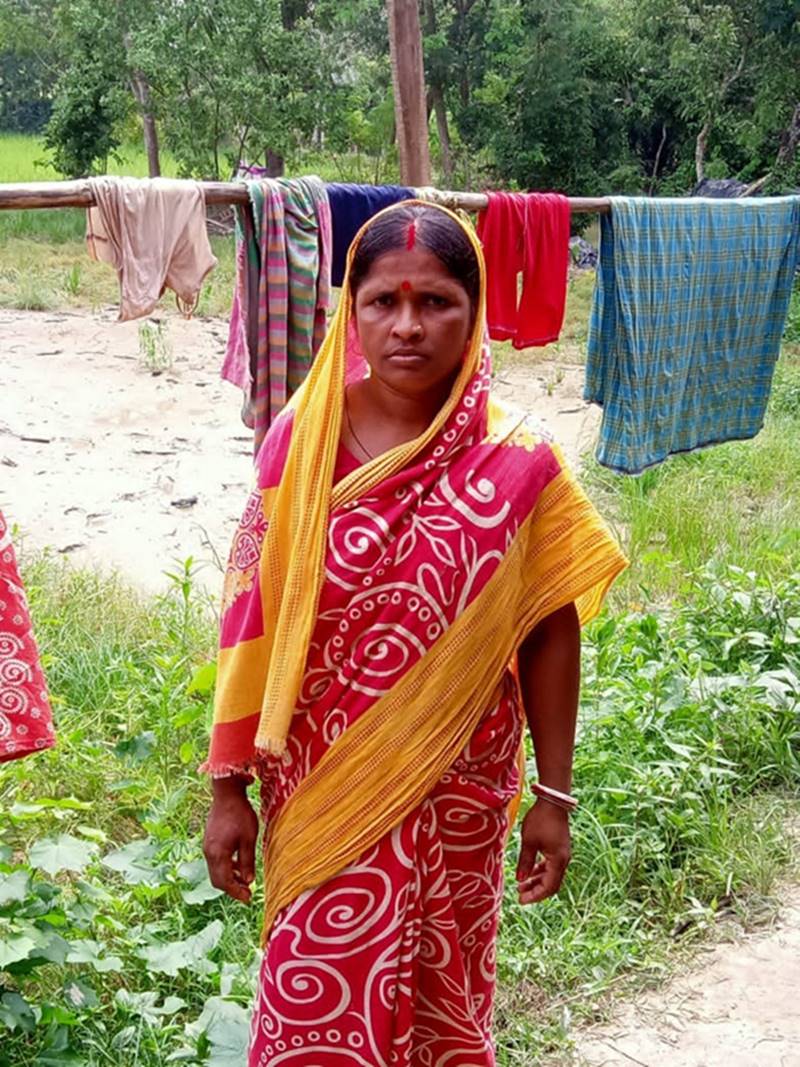
According to her, their work is not limited to a day long drive alone.
“Apart from planting these mangroves, we also guard these saplings. We have to protect them from cows and goats who eat their leaves. Besides, fishermen also uproot these saplings,” the 35-year-old added.
As part of the contract with the non-profit, these rural women have to guard these saplings till they grow over five feet in height. This means an additional responsibility for at least one to one-and-a-half-year.
“It is precisely for this reason that we have signed a year-long contract with these women,” Kolkata-based Faiz Ahmed Khan, programme manager, SEEDS India, told Gaon Connection.
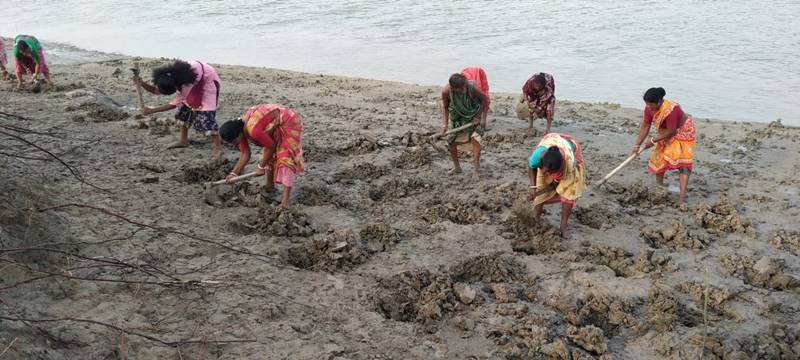
When building resilience is a source of income
As part of this joint initiative and the year long contract, Rs 90,000 are to be given in three installments to the 16 self-help group women.
“We have released the first installment of thirty thousand… We are trying to cover the five acre land with mangroves. In the past two-three years, ten to fifteen acre (four to six hectares) mangrove cover in Gopal Nagar and nearby villages has been destroyed due to cyclones,” informed Khan, adding that the project is supported by donors.
Once the mangroves are planted, the only role of the women is to safeguard them for a year.
“Because of the cyclones, the land mass near homes gets eroded. Several houses are damaged too. This is where mangroves help. We are eyeing local species of mangroves such as vine. Its capacity of stopping erosion is very high,” informed the programme manager.
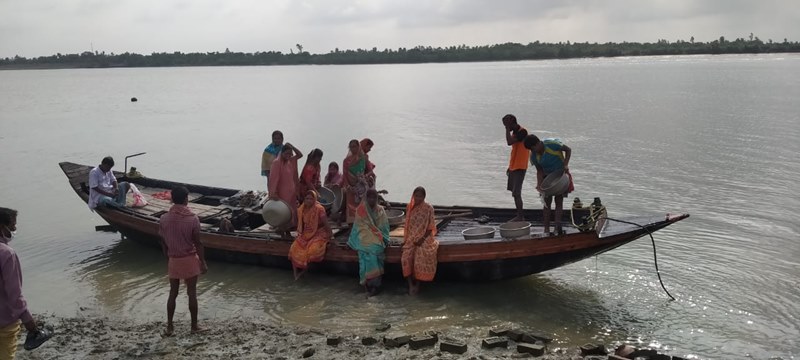
Climate experts point out that community ownership of mangroves is important so they can look after the saplings. Also they stress that such afforestation events should not remain limited to a day or two. “Unfortunately such initiatives are only a day-long drive. If these saplings are not maintained, mangrove mortality gets high,” Vashisht said. He stressed that the restoration of native mangrove species needs to be prioritised to save the communities from extreme weather events.
According to India State of Forest Report (2019), West Bengal has 42.45 per cent of India’s mangrove cover. It is followed by Gujarat (23.66 per cent) and Andaman and Nicobar islands (12.39 per cent). The mangroves in Bengal are spread over an area of 2,112 square km across South 24-Parganas (2,082 sq km), North 24-Parganas (25 sq km) and Purba (East) Midnapore (four sq km).
But like other forests, the mangrove cover is also under threat, which is leading to coastal erosion. Das and 15 other women in her SHG are hopeful that the green barriers they are planting will help lessen the impact of cyclones and safeguard their village.

